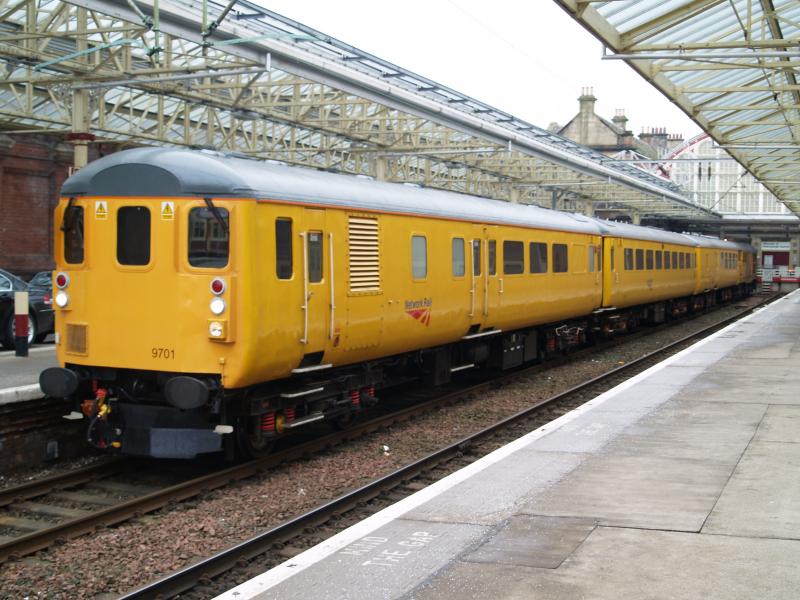DBSO Push-Pull
Welcome to scot-rail.co.uk, Scotland's online railway community. The group is for any rail enthusiast interested in the railways and trains of Scotland. It not only consists of the wiki that you're reading now, but a busy online forum and mailing list, which was accessible to registered users. From April 2024 the forum has closed, with a replacement started on Groups.io.
Breadcrumb navigation
The Mk2f DBSO (Driving Brake Standard Open) coaches were originally converted for use with Class 47/7 diesel locomotives working Push-Pull trains between Glasgow and Edinburgh.
- 9701-9710 (and Locos 47701-47712) converted in 1979 for E&G route.
- 9706 (and MK3s 11004, 12006) cut up after Polmont crash in 1984.
- 9711-9713 (and locos 47713-716) converted in 1985 for Glasgow - Aberdeen with Mk2d stock.
- 9714 converted in 1986 (9706 replacement)
- Loco 47717 converted to replace fire-damaged 47713 in 1988.
- The DBSO coaches were converted at Glasgow Works from 1974-built Mk2f BSO coaches.
- The rebuild involved fitting the brake-van end with a half-cab and a 4-position EMU style power controller linked to the Push-Pull control transmitter.
- The Push-Pull control was known as "Brush two-wire system". It used Time Division Multiplexing and Frequency Modulation but was much simpler than the later TDM systems.
- This system sent pulsed control signals through the carriage lighting control circuits, and existing coach-end RCH cables. This meant any air-braked coach could be include in the formation.
- Cab-end gangway connections were retained, but were given a wooden cover with a window.
- Initially the DBSO push-pulls worked with Mk3 coaches on the Edinburgh Waverley - Glasgow Queen Street (E&G) route.
- Trials started in August 1979 and the first DBSO push-pull set in passenger service ran on 22nd October 1979, powered by locomotive 47709. Further sets were introduced to replace the class 27 push-pulls by February 1980.
- From April 1981, a Mk3 push-pull set, with the addition of a Mk1 buffet car was deployed on two daily services between Glasgow Queen Street and Aberdeen.
- From March 1982, an additional Push-pull set was formed with disk-braked, non-air conditioned early Mk2 coaches (previously deployed on the E&G route in the 1970s).
- Obstacle Deflectors were fitted in from March 1985 in response to the Polmont crash.
- The locomotives and push-pull trains were repainted in ScotRail Express livery (with a light blue stripe) between Autumn 1984/Spring 1985.
- Extra DBSOs were converted for use on the Glasgow - Aberdeen route from May 1985, with existing Mk2d stock.
- Whether on Edinburgh or Aberdeen duties, the usual formation had the DBSO at the Glasgow end of the train.
- An additional Push-pull set was formed in 1986 to work an Edinburgh - Aberdeen diagram.
- Push-pull sets were used on Summer Sunday Oban line excursions in the 1980s. These were conventionally hauled; in 1981 by Deltic 55021, or by class 37 with an ETHEL used 1983-1985.
- ScotRail's Push-Pull trains were to be replaced by Class 158 DMUs and although introduction of these were delayed by more than a year, the dedicated ScotRail Express stock was progressively transferred away from the Autumn of 1989, with the last few DBSOs remaining in use in June 1990. During the transition period various Intercity 'red-stripe' Mk2 & Mk3 coaches were borrowed.
- The DBSOs were redeployed on the London Liverpool Street - Norwich route in 1990. At this time they overhauled at Derby works, the cab end gangways were removed, and updated TDM (Time Division Multiplex) control equipment compatible with electric locomotives was fitted.
- After the DBSO coaches has been replaced on the London - Norwich route, some were taken on by Network Rail for use on Infrastructure monitoring trains.
Former DBSO, RTOV 9701 working with a Class 31 on 1Q21 at Helensburgh Central, 13 Feb 2009 Photo by darrel
See Also
- Wikipedia - DBSO
- Flickr - 9711 at Glasgow Queen Street, 18/06/90. Possibly the last DBSO in use by ScotRail
- Railforums.co.uk - Description of Brush Two-wire system push-pull control
- Flickr - DBSO 9702 minus gangway cover, at Glasgow Works, 1980
- Flick - ScotRail Express Gallery

